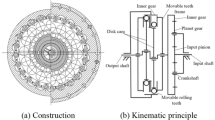Abstract
Three-roll cross rolling (TRCR) is a new advanced plastic forming technology to manufacture rings with small hole and deep groove (RSD), such as duplicate gear. Force parameters are the important basis for plastic forming technology design and equipment selection. So, it is necessary to establish a rational method of calculating force parameters. As the deformation process of TRCR is controlled by multifactors coupling interactive effects, to establish a universal design approach for comprehensive consideration of various parameters which affect the force and energy parameters, considering various kinds of factors with finite element analysis (FEA) method, a great quantity model and data analysis must be developed, which is more time-consuming and difficult to summarize the effective rule. While based on related supposition and simplified calculation, a common analytical method can be adopted quickly with the traditional plastic mechanics theory. Therefore, analytical models of rolling power, torque, and force are built in the paper, by means of the classic plastic mechanics theory of upper bound method combined with static analysis and calculation of kinematical admissible velocity field. Then, comparing to the results in FEA models of different sizes of workpieces and kinematic parameters of rolls under ABAQUS/Explicit environment, analytical models are corrected. As a consequence, the effect rules of workpiece sizes and roll kinematic parameters on force parameters display the same, and corrected analytical model has a great agreement with FEA, which provides reliable calculation basis for the design of force parameters in TRCR of RSD.
Similar content being viewed by others
References
Zhou XM, Hua L, Qian DS. FE modeling of three rolls cross rolling process of a rotary disk part. In: 2nd International Conference on Manufacturing Science and Engineering, ICMSE 2011, April 9, 2011 - April 11, 2011, Guilin, China, 2011. Advanced Materials Research. Trans Tech Publications, pp 1991-1996. doi:10.4028/www.scientific.net/AMR.189-193.1991
Ma Q, Hua L, Qian DS Coupled thermo-mechanical FEA of three-roll cross rolling process for rings with small-hole and deep groove. In: 2012 Spring International Conference on Material Sciences and Technology, MST-S, May 27, 2012 - May 30, 2012, Xi'an, China, 2012. Advanced Materials Research. Trans Tech Publications, pp 846-852. doi:10.4028/www.scientific.net/AMR.560-561.846
Qian DS, Zhang ZQ, Hua L (2013) An advanced manufacturing method for thick-wall and deep-groove ring—Combined ring rolling. J Mater Process Technol 213(8):1258–1267. doi:10.1016/j.jmatprotec.2013.01.024
Qian DS, Hua L, Deng JD (2012) FE analysis for radial spread behavior in three-roll cross rolling with small-hole and deep-groove ring. Transactions of Nonferrous Metals Society of China 22(Suppl. 2):s247–s253. doi:10.1016/S1003-6326(12)61715-4
Yea Y, Ko Y, Kim N, Lee J (2003) Prediction of spread, pressure distribution and roll force in ring rolling process using rigid–plastic finite element method. J Mater Process Technol 140(1–3):478–486. doi:10.1016/S0924-0136(03)00721-0
Zhao YM, Qian DS (2010) Effect of rolling ratio on groove-section profile ring rolling. J Mech Sci Technol 24(8):1679–1687. doi:10.1007/s12206-010-0525-y
Wang M, Yang H, Zhang C, L-g G (2012) Microstructure evolution modeling of titanium alloy large ring in hot ring rolling. Int J Adv Manuf Technol 66(9–12):1427–1437. doi:10.1007/s00170-012-4420-9
Wang MT, Li XT, Du FS, Zheng YZ (2005) A coupled thermal-mechanical and microstructural simulation of the cross wedge rolling process and experimental verification. Mater Sci Eng A 391(1–2):305–312. doi:10.1016/j.msea.2004.08.080
Wong CC, Danno A, Tong KK, Yong MS (2008) Cold rotary forming of thin-wall component from flat-disc blank. J Mater Process Technol 208(1–3):53–62. doi:10.1016/j.jmatprotec.2007.12.123
Hahn YH, Yang DY (1991) UBET analysis of roll torque and profile formation during the profile ring-rolling of rings having rectangular protrusions. J Mater Process Technol 26(3):267–280. doi:10.1016/0924-0136(91)90063-K
Sezek S, Aksakal B, Can Y (2008) Analysis of cold and hot plate rolling using dual stream functions. Mater Des 29(3):584–596. doi:10.1016/j.matdes.2007.03.005
Li Y, Liu Z, Lu H, Daniel WJT, Liu S, Meehan PA (2014) Efficient force prediction for incremental sheet forming and experimental validation. Int J Adv Manuf Technol 73(1–4):571–587. doi:10.1007/s00170-014-5665-2
Zhang SH, Zhao DW, Gao CR (2012) The calculation of roll torque and roll separating force for broadside rolling by stream function method. Int J Mech Sci 57(1):74–78. doi:10.1016/j.ijmecsci.2012.02.006
Hua L, Huang XG, Zhu CD (2001) Theory and technology of ring rolling. China Machine Press, Beijing (in Chinese)
Lin ZP (1991) Application of upper bound method in the plastic processing technology. Railway Press, Beijing (in Chinese)
Zhou G, Hua L, Lan J, Qian DS (2010) FE analysis of coupled thermo-mechanical behaviors in radial–axial rolling of alloy steel large ring. Comput Mater Sci 50(1):65–76. doi:10.1016/j.commatsci.2010.07.008
Qian D, Pan Y (2013) 3D coupled macro–microscopic finite element modelling and simulation for combined blank-forging and rolling process of alloy steel large ring. Comput Mater Sci 70(0):24–36. doi:10.1016/j.commatsci.2012.12.035
Lin YC, Chen M-S, Zhong J (2008) Constitutive modeling for elevated temperature flow behavior of 42CrMo steel. Comput Mater Sci 42(3):470–477. doi:10.1016/j.commatsci.2007.08.011
Pan JZ (2000) Pressure vessel material practical manual. Chemical Industry Press, Beijing (in Chinese)
Author information
Authors and Affiliations
Corresponding authors
Rights and permissions
About this article
Cite this article
Hua, L., Deng, J., Qian, D. et al. Using upper bound solution to analyze force parameters of three-roll cross rolling of rings with small hole and deep groove. Int J Adv Manuf Technol 76, 353–366 (2015). https://doi.org/10.1007/s00170-014-6107-x
Received:
Accepted:
Published:
Issue Date:
DOI: https://doi.org/10.1007/s00170-014-6107-x



